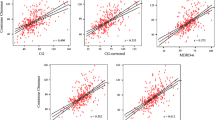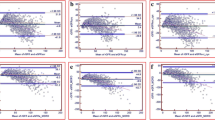Abstract
Aim
To assess the accuracy of the CG, CG-corrected, MDRD-6, MDRD-4 and CKD-EPI formulae when diagnosing CKD and to compare the results for creatinine clearance.
Subject and methods
This cross-sectional study was conducted with hypertensive individuals monitored by the Primary Health Care Service in Brazil (n = 293). Renal function was analyzed based on serum creatinine levels and creatinine clearance (24 h). The GFR was estimated using the CG, CG-corrected, MDRD-6, MDRD-4 and CKD-EPI formulae. The accuracy of the CKD diagnosis was assessed by analyzing sensitivity and specificity with confidence intervals (95%), receiver-operator characteristic (ROC) curve and the area under the curve (AUC) values.
Results
The CKD-EPI formula provided the best balance between sensitivity, 76.7 (66.4–85.2), and specificity, 71.9 (65.3–78.0), as well as the highest AUC value (0.808). Concerning the ROC analysis, the curve of the CKD-EPI formula confirmed its greater precision.
Conclusions
The results of the present study indicate that the CKD-EPI formula is the best method for estimating the GFR. Thus, it is possible to implement low-cost actions focused on the early detection and prevention of complications of CKD.

Similar content being viewed by others
References
Bastos M, Bastos R, Paula R (2007) Avaliação da função renal. In: Barros E, Gonçalves L (eds) Nefrologia no consultório. Artmed, Porto Alegre, pp 49–67
Bastos MG, Kirsztajn GM (2011) Chronic kidney disease: importance of early diagnosis, immediate referral and structured interdisciplinary approach to improve outcomes in patients not yet on dialysis. J Bras Nefrol 33:74–87
Brown WW, Peters RM, Ohmit SE, Keane WF, Collins A, Chen SC, King K, Klag MJ, Molony DA, Flack JM (2003) Early detection of kidney disease in community settings: the kidney early evaluation program (KEEP). Am J Kidney Dis 42:22–35
Cockcroft DW, Gault MH (1976) Prediction of creatinine clearance from serum creatinine. Nephron 16:31–41
Coresh J, Selvin E, Stevens LA, Manzi J, Kusek JW, Eggers P, Van Lente F, Levey AS (2007) Prevalence of chronic kidney disease in the United States. JAMA 298:2038–2047. doi:10.1001/jama.298.17.2038
Hamer RA, El Nahas AM (2006) The burden of chronic kidney disease. BMJ 332:563–564. doi:10.1136/bmj.332.7541.563
Jelliffe D (1968) Evaluación del estado de nutrición de la comunidad Ginebra: OMS :260–261
Jha V, Garcia-Garcia G, Iseki K, Li Z, Naicker S, Plattner B, Saran R, Wang AY, Yang CW (2013) Chronic kidney disease: global dimension and perspectives. Lancet 382:260–272
Kidney Disease: Improving Global Outcomes (KDIGO) CKD Work Group (2013) KDIGO 2012 clinical practice guideline for the evaluation and Management of Chronic Kidney Disease. Kidney Int 3:1–150
Kirsztajn GM, Souza E, Romão Jr JE, Bastos MG, Meyer F, Andrada N (2011) Doença Renal Crônica (Pré-terapia Renal Substitutiva): Diagnóstico
Lamb EJ, Stevens PE (2014) Estimating and measuring glomerular filtration rate: methods of measurement and markers for estimation. Curr Opin Nephrol Hypertens 23:258–266
Levey AS, Bosch JP, Lewis JB, Greene T, Rogers N, Roth D (1999) A more accurate method to estimate glomerular filtration rate from serum creatinine: a new prediction equation. Ann Intern Med 130:461–470
Levey A, Bosch J, Lewis J, Shahriari AR, Rogers N, Roth D (2000) A simplified equation to predict glomerular filtration rate from serum creatinine. J Am Soc Nephrol 11:155A
Levey AS, Coresh J, Greene T, Stevens LA, Zhang YL, Hendriksen S, Kusek JW, Van Lente F, Chronic Kidney Disease Epidemiology Collaboration (2006) Using standardized serum creatinine values in the modification of diet in renal disease study equation for estimating glomerular filtration rate. Ann Intern Med 145:247–254
Levey AS, Stevens LA, Schmid CH, Zhang YL, Castro AF 3rd, Feldman HI, Kusek JW, Eggers P, Van Lente F, Greene T, Coresh J, Chronic Kidney Disease Epidemiology Collaboration (2009) A new equation to estimate glomerular filtration rate. Ann Intern Med 150:604–612
Lipschitz DA (1994) Screening for nutritional status in the elderly. Primary care 21:55–67
Lozano R, Naghavi M, Foreman K, Lim S, Shibuya K, Aboyans V, … Murray CJL (2013) Global and regional mortality from 235 causes of death for 20 age groups in 1990 and 2010: a systematic analysis for the global burden of disease study 2010 Lancet 380:2095–2128
Ma YC, Zuo L, Chen JH, Luo Q, Yu XQ, Li Y, Xu JS, Huang SM, Wang LN, Huang W, Wang M, Xu GB, Wang HY (2006) Modified glomerular filtration rate estimating equation for Chinese patients with chronic kidney disease. J Am Soc Nephrol 17:2937–2944
Matsudo S, Araújo T, Marsudo V, Andrade D, Andrade E, Braggion G (2001) Questinário internacional de atividade f1sica (IPAQ): estudo de validade e reprodutibilidade no Brasil. Rev Bras Ativ Fís Saúde 6:05–18
Motta VT, Oliveira Filho, PFd (2009) SPSS: Análise de dados biomédicos. In: SPSS: análise de dados biomédicos. Medbook
Rossing P, Rossing K, Gæde P, Pedersen O, Parving H-H (2006) Monitoring kidney function in type 2 diabetic patients with incipient and overt diabetic nephropathy. Diabetes Care 29:1024–1030
Rule AD, Gussak HM, Pond GR, Bergstralh EJ, Stegall MD, Cosio FG, Larson TS (2004) Measured and estimated GFR in healthy potential kidney donors. Am J Kidney Dis 43:112–119
Shemesh O, Golbetz H, Kriss JP, Myers BD (1985) Limitations of creatinine as a filtration marker in glomerulopathic patients. Kidney Int 28:830–838
Silva ABT, Molina MCB, Rodrigues SL, Pimentel EB, Baldo MP, Mill JG (2010) Correlação entre a depuração plasmática de creatinina utilizando urina coletada durante 24 horas e 12 horas. J Bras Nefrol 32:165–172
Sistema de Hipertensão e Diabetes (SisHiperDia) (2012) Ministério da Saúde. DATASUS. Número de Diabéticos, Hipertensos e Diabéticos com Hipertensão por sexo, tipo e risco. http://hiperdia.datasus.gov.br. Accessed 12 April 2012
Sociedade Brasileira de Nefrologia (2013) Censo da Sociedade Brasileira de Nefrologia. http://arquivos.sbn.org.br/pdf/censo_2013_publico_leigo.pdf. Accessed 07 July 2014
Sodré FL, Costa JCB, Lima JCC (2007) Avaliação da função e da lesão renal: um desafio laboratorial:[revisão]. J Bras Patol Med Lab 43:329–337
USRDS (2015) United States renal data system. 2015 USRDS annual data report: epidemiology of kidney disease in the United States. National Institutes of Health, National Institute of Diabetes and Digestive and Kidney Diseases, Bethesda
World Health Organization (2000) Obesity: preventing and managing the global epidemics (Series 894) World Health Organization
Author information
Authors and Affiliations
Corresponding author
Ethics declarations
Funding
This study received support from the Foundation for Research Support in the State of Minas Gerais, Brazil (FAPEMIG-process no. CDS-APQ-03594-12) and the Coordination for the Improvement of Higher Education (CAPES), an entity of the Brazilian Government that coordinates human resources (AUX-PE-PRO-HEALTH EDUCATION 2034/2010–process no. 23038.009788/2010-78).
Disclosure of potential conflicts of interest
The authors declare that they have no conflict of interest.
Ethical approval
All procedures performed in studies involving human participants were in accordance with the ethical standards of the institutional and/or national research committee and with the 1964 Helsinki Declaration and its later amendments or comparable ethical standards.
The present study was approved by the Human Research Ethics Committee of the Universidade Federal de Viçosa (UFV) under protocol no. 044/2012.
Informed consent
Informed consent was obtained from all individual participants included in the study. As per Resolution 466/2012 of the National Health Council, which regulates research involving human subjects, the participants signed a free and informed statement of consent, which ensured the confidentiality of the data and the anonymity of the participants.
Rights and permissions
About this article
Cite this article
da Silva, L.S., Cotta, R.M.M., Moreira, T.R. et al. Diagnostic accuracy of different methods of early detection of chronic kidney disease. J Public Health 25, 401–407 (2017). https://doi.org/10.1007/s10389-017-0803-6
Received:
Accepted:
Published:
Issue Date:
DOI: https://doi.org/10.1007/s10389-017-0803-6




